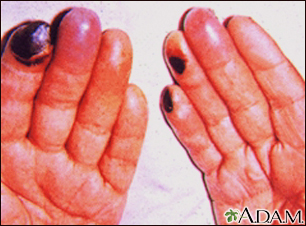Cryoglobulins
Cryoglobulins are antibodies that become solid or gel-like at low temperatures in the laboratory. This article describes the blood test used to check for them.
In the laboratory, cryoglobulins come out of solution in blood when the blood sample is cooled below 98.6°F (37°C). They dissolve again when the sample is warmed up.
Cryoglobulins come in three main types, but in most cases the cause of having cryoglobulins is hepatitis C. The disease in which cryoglobulins are found is called cryoglobulinemia. Cryoglobulins can cause inflammation in blood vessels, called vasculitis. They may also cause inflammation in the kidney, nerves, joints, lungs and skin.
Images


I Would Like to Learn About:
How the Test is Performed
Because they are temperature sensitive, cryoglobulins are hard to accurately measure. The blood specimen must be collected in a special way. The test should only be done in laboratories that are equipped for it.
Blood is drawn from a vein. A vein on the inside of the elbow or the back of the hand is used in most cases. Blood should NOT be drawn from a catheter that has heparin in it. The site is cleaned with germ-killing medicine (antiseptic). The health care provider wraps an elastic band around the upper arm to apply pressure to the area and make the vein swell with blood.
Next, the provider gently inserts a needle into the vein. The blood collects into an airtight vial or tube attached to the needle. The elastic band is removed from your arm. The vial should be warm at room or body temperature, before it is used. Vials that are colder than room temperature before being processed at the laboratory may not give accurate results.
Once the blood has been collected, the needle is removed, and the puncture site is covered to stop any bleeding.
How to Prepare for the Test
You may want to call ahead to ask to have your blood drawn by a lab technician who has experience collecting blood for this test.
How the Test will Feel
Some people feel discomfort when the needle is inserted. Afterward, there may be some throbbing.
Why the Test is Performed
This test is most often done when a person has symptoms of a condition associated with cryoglobulins. Cryoglobulins are associated with cryoglobulinemia. They also occur in other conditions that affect the skin, joints, kidneys, and nervous system.
Normal Results
Normally, there are no cryoglobulins.
Note: Normal value ranges may vary slightly among different laboratories. Talk to your provider about the meaning of your specific test results.
The example above shows the common measurement for results for these tests. Some laboratories use different measurements or may test different specimens.
What Abnormal Results Mean
A positive test may indicate:
- Cryoglobulinemia
- Hepatitis (especially hepatitis C)
- Infectious mononucleosis
- Leukemia
- Lymphoma
- Macroglobulinemia -- primary
- Multiple myeloma
- Rheumatoid arthritis
- Systemic lupus erythematosus
Additional conditions under which the test may be performed includes nephrotic syndrome.
Risks
Risks associated with having blood drawn are slight, but may include:
- Excessive bleeding
- Fainting or feeling lightheaded
- Hematoma (blood accumulating under the skin)
- Infection (a slight risk any time the skin is broken)
Related Information
MononucleosisHodgkin lymphoma
Waldenstrom macroglobulinemia
Multiple myeloma
Rheumatoid arthritis
Systemic lupus erythematosus
Nephrotic syndrome
References
De Vita S, Gandolfo S, Quartuccio L. Cryoglobulinemia. In: Hochberg MC, Gravallese EM, Smolen JS, van der Heijde D, Weinblatt ME, Weisman MH, eds. Rheumatology. 8th ed. Philadelphia, PA: Elsevier; 2023:chap 171.
McPherson RA, Riley RS, Massey HD. Laboratory evaluation of immunoglobulin function and humoral immunity. In: McPherson RA, Pincus MR, eds. Henry's Clinical Diagnosis and Management by Laboratory Methods. 24th ed. Philadelphia, PA: Elsevier; 2022:chap 47.
Rajkumar SV. Plasma cell disorders. In: Goldman L, Cooney KA, eds. Goldman-Cecil Medicine. 27th ed. Philadelphia, PA: Elsevier; 2024:chap 173.
Stone JH. Immune complex-mediated small-vessel vasculitis. In: Firestein GS, McInnes IB, Koretzky GA, Mikuls TR, Neogi T, O'Dell JR, eds. Firestein & Kelley's Textbook of Rheumatology. 12th ed. Philadelphia, PA: Elsevier; 2025:chap 92.
BACK TO TOPReview Date: 1/28/2025
Reviewed By: Diane M. Horowitz, MD, Rheumatology and Internal Medicine, Northwell Health, Great Neck, NY. Review provided by VeriMed Healthcare Network. Also reviewed by David C. Dugdale, MD, Medical Director, Brenda Conaway, Editorial Director, and the A.D.A.M. Editorial team.

Health Content Provider
06/01/2025
|
A.D.A.M., Inc. is accredited by URAC, for Health Content Provider (www.urac.org). URAC's accreditation program is an independent audit to verify that A.D.A.M. follows rigorous standards of quality and accountability. A.D.A.M. is among the first to achieve this important distinction for online health information and services. Learn more about A.D.A.M.'s editorial policy, editorial process and privacy policy. A.D.A.M. is also a founding member of Hi-Ethics. This site complied with the HONcode standard for trustworthy health information from 1995 to 2022, after which HON (Health On the Net, a not-for-profit organization that promoted transparent and reliable health information online) was discontinued. |
The information provided herein should not be used during any medical emergency or for the diagnosis or treatment of any medical condition. A licensed medical professional should be consulted for diagnosis and treatment of any and all medical conditions. Links to other sites are provided for information only -- they do not constitute endorsements of those other sites. © 1997- 2025 A.D.A.M., a business unit of Ebix, Inc. Any duplication or distribution of the information contained herein is strictly prohibited.
